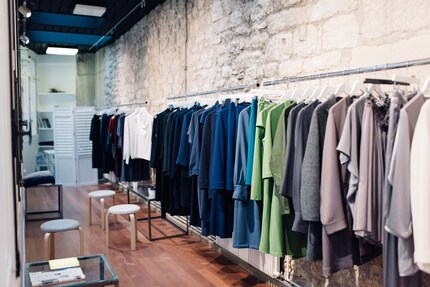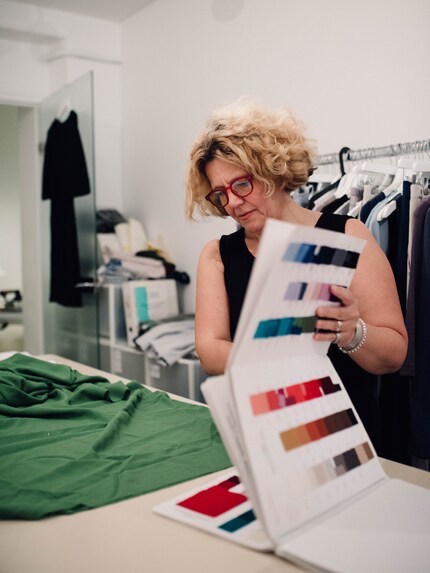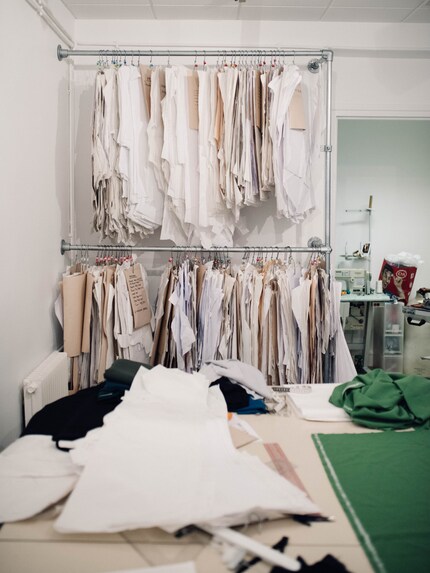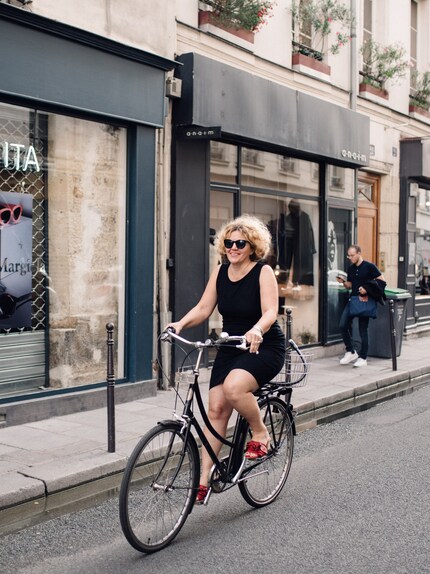
Background information
A reflective nation: lessons in visibility from Finland
by Martin Jungfer

Finnish designer Anna Ruohonen is synonymous with sustainable fashion. She also uses her pieces to make a statement in her adopted home of Paris, where slow fashion isn’t even a talking point.
Anna Ruohonen’s atelier is hidden behind a huge wooden door in the lively centre of the Parisian district Marais. The heavy door only opens when you push a button. Once inside, you realise it was hiding a paving stone path towards the real entrance. There’s something mysterious about it. «That’s what gives the shop its charm,» says Anna. «Everyone knows that French women are secretive and don’t like to share tips. Never ask a French woman what perfume she’s wearing. She’d rather not answer than tell you,» explains the women’s fashion designer with a laugh. So she really appreciates it when customers tell others about her shop.
Anna has used the well-lit studio as a shop and sewing atelier for a year and a half. Everything is clean and tidy. And the wall is lined with clothes rails. The designer’s creations are grouped by colour and hang on white wooden hangers. Anna’s pieces follow Nordic design: the cut of the clothes is sophisticated and the simplicity is intentional. «I don’t follow trends. My designs are neither in nor out of fashion.»

Anna focuses on sustainability – at work as well as at home. That’s why for over ten years she’s only been making orders once they’ve been placed. This prevents waste from excess or unsold pieces or unnecessary supplies or prototypes at the end of each season. «Why should I make pieces that I might end up just sitting on?» The designer is also aware that she relies on her customers’ patience. As the environment is also an issue close to their hearts, for the most part they appreciate her approach. «If I have all the material in stock, in an emergency I can have an order ready to pick up the next day.» This is especially handy for tourists who are only in Paris for a few days. Locals don’t tend to use the next-day service very often. The designer also has a second shop in Helsinki. Given the clothes are produced in Paris, Finnish customers have to wait three to four weeks for their orders.
At the end of the 90s, Anna moved from her hometown of Helsinki to Paris, where she was an exchange student at L'Institut Français de la Mode. Before she set up her own self-titled brand in 1999, she worked for renowned designers, such as Martin Margiela. At that time she also worked for independent design projects as well as designing fabric and prints for various Finnish textile companies and creating costumes for French film and theatre projects. She only intended to stay six months in Paris but it’s coming up for 25 years now. «What fascinates me about Paris is the people and the different cultures that inspire me every day.» Now her children go to school in France she has yet another connection to the country.

Although Anna runs an online shop alongside the two physical stores, she insists on continuing a brick-and mortar-presence where customers can try on clothes and touch the fabric. Her clientele pay between 180 and 950 euros for a dress after all. This includes alterations by a seamstress when you collect it to make sure it fits perfectly. Anna has high standards and doesn’t think her sewing is good enough. That’s why she has two seamstresses working in her atelier.
Another advantage of her physical shop is the personalised touch. It lets her customers explain what they’re looking for so she can integrate this into her designs. «Once women get to a certain age, many don’t like to show their arms – me included. So I create a lot of longer sleeved pieces,» she says with a chuckle. The personal touch is also linked to the fact she sometimes has to justify her prices because she only uses high-quality, natural materials such as silk, wool, mohair and cashmere. «Quality comes at a price. French women often don't understand that. My pieces are like new even after you've worn them many times.» This means customers can enjoy them for a long time to come. Her goal is to create favourite pieces that you never discard. Instead women would pass them down to their daughters. Secondhand fashion is also a great way to do your bit for the planet.
Anna explains why she opted for made-to-order fashion as opposed to mass production. The advantage of large-scale fabrication is lower production costs. But it often means there are pieces left unsold at the end of the season, even after the sales. And that’s when sellers are forced to slash prices. «You don’t just lose a large part of your margin, you also have to burn the surplus, which fortunately costs extra.» She tells me how crazy it is to get rid of perfectly good pieces in this way. «The worldwide production of clothes is twice the amount we could possibly ever wear.»

We also have to learn the true cost of clothing. «If you buy a cheap shirt for 10 francs and only wear it twice, it works out at 5 francs per day. At that calculation, it’s more expensive than a fairtrade shirt for 100 francs that you wear more than 100 times in the coming years.» Besides, a cheap shirt wouldn’t be able to withstand that many washes. «People are trained to pay more attention to price tags than quality,» says Anna with frustration and shakes her head of blond curly hair.
«That’s why I don’t release lots of collections per year like other designers do.» Slow fashion is the magic phrase. She often changes the colours or alters the cut on a current piece. These kinds of small things make the difference. «Why should I remove a dress from my collection when it has sold well for 20 years?» If it sells well, Anna says she’s done her job well.
Both Anna’s adoptive and native home cities are interesting places when it comes to fashion. Paris is the fashion metropolis par excellence, while Helsinki is at the forefront of environmentalism, as Scandinavians like to shop consciously by choosing sustainable fashion. Helsinki Fashion Week has been held here once a year since 2015; Anna also takes part and uses it as an opportunity to showcase her work. Helsinki Fashion Week is all about sustainability. The goal of «HFW» is to encourage conscious consumption and environmentalism. Meanwhile in Paris, the Circular Fashion Summit, focuses on sustainability in the fashion industry. The first edition only started last September. It’s clear to see that in environmental concerns, France lags far behind. They’re essentially starting from zero. Many French people don’t even know what natural fibres are. «Only once everyone has reached a base level of understanding will people start searching for solutions to the problem,» explains Anna, while shaking her head. «As long as French people consume fast fashion, nothing will change.»
«We produce plastic so sports brands can make supposedly sustainable trainers.»
One of the biggest environmental problems is waste. «We have to take action and not just talk about it,» warns Anna. In fact, that’s one of the many reasons she opted for the made-to-order concept. These days people order everything online and then wait for it to arrive. When it comes to furniture and cars, we expect longer delivery times. Why should it be any different for clothes? «We have to change the way we consume things.» Recycling and upcycling isn’t the solution. «Instead we should stop making plastic bottles just so sports brands can make supposedly sustainable trainers from them. That’s the epitome of greenwashing.»

Anna doesn’t just apply her values to her work. They also flow over to her personal life. Sustainability at home translates into no one in her family having a car. «I live in the 14th arrondissement so the journey to work is a good workout.» Cycling to work means she has a positive carbon footprint. What’s more, she hardly eats red meat, only buys what she needs and flies as little as possible. «I avoid plastic so I only drink out of glass bottles.» When the designer goes to the supermarket, she avoids all food in unnecessary plastic. That might seem like be a drop in the ocean in terms of the amount of plastic in the world, but it could make a huge difference if everyone does their bit.
When I’m not exploring the depths of the sea as an open water diver, I enjoy plunging into the world of fashion. On the streets of Paris, Milan and New York is where I keep my eyes peeled for the latest trends. And I’ll show you how to take them from the catwalk to your everyday life.
Interesting facts about products, behind-the-scenes looks at manufacturers and deep-dives on interesting people.
Show all